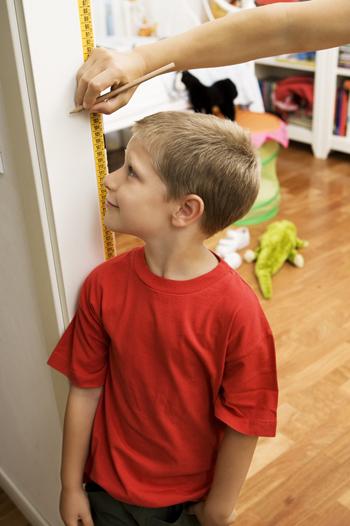How tall am I?
Duration/age

You can help your child learn about growing by measuring their height over time.
Have your child stand next to the door jamb. They need to stand straight and tall. Rest a ruler or book on your child’s head - touching it lightly against the wall - and use a pencil to mark their height. Measure the distance from the floor to the mark using a tape measure or a ruler. Write your child's height and the date next to the mark on the wall. Don’t forget to measure everyone in the family - even the grown-ups and the dog!
Materials you will need
- Pencils
- Ruler
- Tape measure
- A book
Alternative tools
- Height chart
Skills this activity improves
Why does this matter?
Height is about measurement. The numbers tell us how big something is. Comparing a child’s different heights over time helps them to learn about growing. Comparing heights of different people helps children learn about diversity. Predicting and estimating are useful skills as they help children to begin to talk about the likelihood of something happening. When we talk about how big or how tall something or someone is we are talking about measuring and the different language that we can use to describe attributes of size.
What does this lead to?
This activity leads to children gaining a better understanding of measurement and how to describe the attributes of size.
Language to use
- Centimetres, metres
- Ruler, tape measure, pencils, book
- Straight, still
- High, tall, taller, tallest, short, shorter, shortest
- Today, last time, next time
- Grown, growing, different
Questions to use
- How can we measure you?
- What else could we measure?
- Do your feet grow? What about your hands or your tummy?
- When will you be as tall as me?
- Will your brother grow as tall as you?
- Why do you keep growing taller but Mum and Dad don’t?
Useful tips
- A paper or cardboard chart is another option so you can take the height chart with you if you move house.
- Measure every six months so that your child can see the changes.
- Remember to talk to your child in your home language.
More ideas
What else could you measure over time? Think about plants, weeds, pets or shadows.
Variation by age
Birth to two year olds
- Set up a height chart for all the family.
- Trace around different parts of your body and compare which is bigger, which is smaller.
- Trace around your hands and feet, cut out the tracings and use them as measuring tools.
Three to five year olds
- Set up a height chart for all the family.
- Trace around different parts of your body and compare which is bigger, which is smaller.
- Trace around your hands and feet, cut out the tracings and use them as measuring tools.
- Set up a measuring toolbox with rulers, tape measures and string for measuring.
- Google the heights or lengths of different animals. Use string to measure the sizes out on the ground and compare the sizes to your child.
Questions to ask
- Who is the biggest in our family?
- Who is the smallest in our family?
- Are your hands bigger than your feet?
- How many 'cut-out' feet long is the verandah?
- How many 'cut-out' hands tall is the fridge?
Questions to ask
- What tool can you use to measure height with?
- Which is bigger, the dog or the elephant?
- How many 'cut-out' feet long is the driveway?
- How many 'cut-out' hands tall is the wall?


